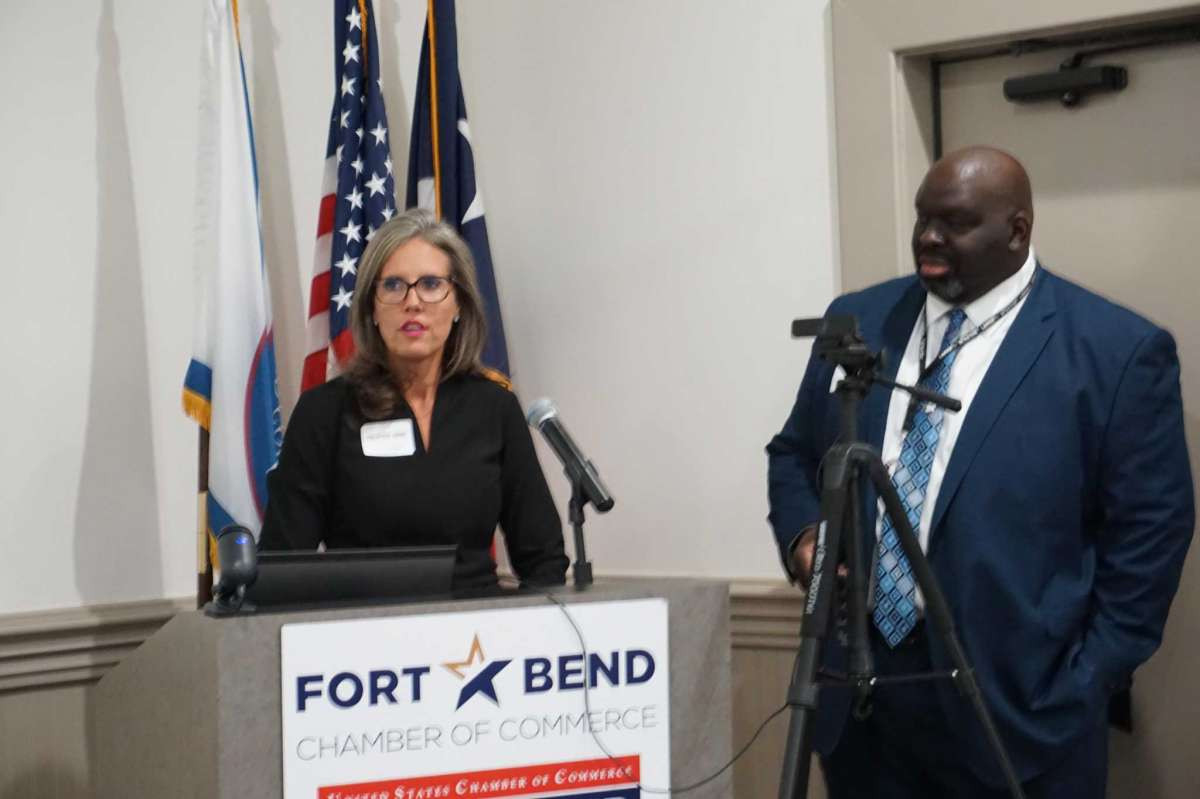
Lamar Consolidated ISD Superintendent Roosevelt Nivens and Board President Joy Williams spoke on the district’s rapid growth, local control, staffing shortages and more during a Nov. 3 luncheon.
The Fort Bend Chamber of Commerce’s Education Division hosted the event that drew stakeholders from the Fort Bend County community to hear about what’s going on in Texas’ fifth fastest-growing school district.
The district covers 385 square miles, or about 43 percent of Fort Bend County. More than 39,000 students attend Lamar CISD schools from 15 municipalities, including Rosenberg, Richmond, Katy and Fulshear. More than 5,000 employees support the students at 46 campuses. More campuses are being added each year.
Demographers project the district will add more than 41,000 new homes over the next decade, serving more than 64,000 students by 2030. The district is projected to need 12 additional schools over the next decade.
“While Lamar CISD’s rapid growth is a sign of thriving schools and an engaged community, it also presents its own set of challenges,” Williams said. “As we continue to open new schools to keep up with our rapid growth, it is also important for us to maintain and update our existing facilities to ensure that all of our students have access to high-quality learning environments.”
The availability of buses, technology and other resources is a challenge, Williams said. The district was transporting around 11,000 on buses at the close of the 2020-21 school year but is now transporting more than 16,000 students.
Williams reported that the district has one of the area’s lowest tax rates and a track record of financial transparency and accountability. She said it has offered its employees salary increases each year for the last 10 years.
The district’s strategic plan, Williams said, focuses on five priorities: adapting the process for student learning, preparing students to be successful in an evolving world, fostering a safe and healthy environment, planning for rapid growth while maintaining the district’s culture and centering in on talent.
She stressed the need for local control for the board to make decisions for its students and communities, giving the example of responding to the pandemic. “We appreciate the ability to make decisions that are specifically tailored to our own community.” When the state presents unfunded mandates, Williams said it poses challenges.
As education faces staffing shortages, Nivens noted a trend that began years ago where fewer students were majoring in education. He attributed it, in part, to society’s devaluing the role of educators and said with fewer students, colleges of education lower their standards for the students they do have. Some teachers, Nivens said, lack proper preparation while others have fallen back on teaching when their corporate careers did not pan out.
He said the district is currently down about 50 staff members and began the school year down about 50 bus drivers and child nutrition staff members. Some classes are doubled up, and some bus drivers run double and triple routes, leaving some students to be picked up 60 or 90 minutes late.
The district is working to recruit student teachers and maintain great relationships with colleges and universities that will send students its way. Nivens said he takes no issue with “begging” talented people to come and stay because they lead to the best outcomes for students.
Lamar CISD also works to support current teachers through employee assistance programs because the pandemic has worn down everyone, Nivens said.
He struggled to read and write until a sixth grade teacher recognized what was going on and intervened. He said the district must make every effort to reach at-risk students, so it partners with groups like the George Foundation that financially support their social-emotional needs.
Conversations about funding the district’s rapid growth are unending, Nivens said. Earlier in the day, he had held a meeting with mayors and city managers from the 15 municipalities it serves to discuss plans. “I always say, ‘What’s best for the city is best for the school, and what’s best for the school is best for the city.’ So we just have to make sure we’ve become strong partners in that and clearly communicate, have two-way communication so we can make sure that we’re doing the best thing we can for students.”
Nivens said as he was researching to become superintendent of Lamar CISD, he was drawn to the district because he could see in online board meetings that the seven board members were all focused on students. In today’s challenging climate, school board members can encounter personal attacks, keyed cars, slashed tires and even death threats. But they join to serve students and communities, Nivens said in thanks.
“They’re here now, and they all have jobs. They all have families and things they need to be doing, but they’re here right now supporting the school system in their volunteer job.”